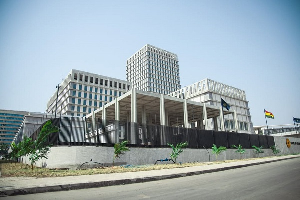One of the few things we who have lived in the diaspora tend to do when we return home, either for a visit or to relocate is to visit places in the local area where we spent time during the formative years of our lives. After all, these places leave an indelible mark on us and give us feelings of nostalgia. It is such urge that took me to the South Labadi Estates area near Regal Cinema, where I lived briefly with my sister immediately after Secondary School. The cinema was of course very dilapidated and not used for what I had memories of. Additionally, I noticed a vast factory that stretched from the main road to the beach.
In front of the factory were stacks of Corrugated Asbestos roofing sheets, presumably ready to be taken to various distributors or markets. Posted on the walls of the factory overlooking the stacks of the asbestos sheets were Obituaries of various demised individuals I assumed were employees or affiliates of the factory. The sight of so much asbestos sheets in a heavily residential area got me a bit concerned. Asbestos is dangerous. Why were the residents of the area moving about with no concern over its presence? Were they aware of the dangers or did they simply not care? My curiosity was fueled by my own experience with regulations on asbestos when I was remodeling my house in Los Angeles, California, to replace my heater with a central air conditioning system. Each of the contractors who came to prepare an estimate for me brought copies of regulations covering procedures for the removal of asbestos material that had been used as insulation for the old heater. They not only had the copies but were also so knowledgeable of the regulations that they could intelligently discuss each of my options with me, and offer me specific references for further perusal if I had additional questions.
With this as a background, I decided to do some research into the rules and regulations concerning Asbestos in Ghana. My initial action was to go to the Ghana Government website on the internet and type in the words, “asbestos regulations”. One of the first items that came up was an article, published in November 2005, in which Professor Kwabena Frimpong Boateng, former Chief Executive of the Korle-Bu Teaching Hospital, called for the Enforcement of the law banning the production and use of asbestos roofing sheets, which had been detected to cause lung cancers. Given the stature of Prof Boateng in our nation, I got very interested in following up on what he was saying. Did he mean that a law existed here in Ghana that he was calling for enforcement of or was he advocating for the passing of such a law and its enforcement? I understood his statement to mean that there is a law, and that this law in fact bans the use of asbestos roofing sheets and his problem was that the law was not being enforced.
To satisfy my curiosity, I followed up by looking at the Website of the Environmental Protection Agency, which I assumed would be the appropriate Government Agency that would oversee the regulation of asbestos, in order to assess the progress we have made in regulating the production, importation and use of not only asbestos sheets, but also all other products containing asbestos. My interest in the EPA should be obvious, after all that is the Government Agency charged with monitoring the safety of our environment, including promulgating regulations and enforcement procedures on various items that affect our environment. Furthermore, Environmental Impact Assessment reports are presented to the Agency for review and approval prior to the commencement of several significant projects including real estate development, mining, quarries, and road construction. I assumed the approval process would entail some guidelines on the handling of asbestos and related product.
I perused the website looking for publications the agency has, that will educate “we the people” on the Government’s Policy on asbestos and, at a minimum, will alert us to the dangers that asbestos poses to us as well as direct us on what to do in cases where it is present or suspected. Before going into the reason for my interest in this information, perhaps I should set the stage by first discussing some attributes of this asbestos substance:
• Asbestos is a mineral fiber that occurs in rock and soil. It is popular among manufacturers and builders because it is good at sound absorption plus, it has average tensile strength, and is resistant to fire, heat, electrical and chemical damage. It is also highly preferred because it is affordable. In Ghana it is commonly used in the building construction for roofing, moldings floor tiles, and, electrical insulation, inter alia. Some of these building materials are manufactured locally but others come in from the importation of automobile parts, paper products, heat resistant products, and packaging and friction products. In short, it is safe to say that we are exposed to asbestos daily because it is found in our buildings, home floors, schools, work and mines since it also occurs naturally in our soils and rocks. Asbestos fibers may be released into the air by the disturbance of asbestos-containing material during product use, demolition work, building or home maintenance, repair, and remodeling. In general, exposure may occur only when the asbestos-containing material is disturbed or damaged in some way to release particles and fibers into the air.
• Three of the major health effects associated with asbestos exposure are lung cancer; mesothelioma, a rare form of cancer that is found in the thin lining of the lung, chest and the abdomen and heart; and asbestosis, a serious progressive, long-term, non-cancer disease of the lungs. Because of its proven fatal effects, several countries have banned all use of asbestos, as well as the extraction, manufacture, and processing of asbestos related products.
• Early detection and immediate action on exposure to asbestos is critical because the length of exposure is directly related to the severity of the illness. Those with long-term exposure usually experience more acute forms of the illness than those with shorter exposure periods.
• Although some people develop serious ailments within a short time after asbestos exposure, some illnesses do not show symptoms until many years, even decades after initial exposure. For example, mesothelioma diagnosis usually occurs decades after the initial exposure to asbestos.
• The survival rate of the diseases caused by asbestos is poor. For instance, mesothelioma cannot be cured with today’s medical knowledge, and the average survival time after diagnosis is only one year. According to some medical sources, only about 10 percent of people diagnosed with this ailment survive more than five years. The survival rate for other types of lung cancer is just as poor with nearly 60 percent dying within one year and 75 percent within two years of diagnosis. About 16 percent of people diagnosed with non-small cell lung cancer survive the disease for more than five years and only about six percent survive more than five years.
Given the above reasons, and the fact that the use of asbestos is so rampant in Ghana, one could see why I am highly interested in finding out what our Government, through the EPA had done about outright banning the use of asbestos, or at least a definitive plan to ensure that its use is gradually diminished and eventually ceased. Further, I expected to see urgent action to minimize exposure to the general population by removing existing known asbestos containing material everywhere. At the very least, seeing a large manufacturing plant located in a heavily populated area should be of a significant concern not only to our public officials but also the health officials and the area residents in particular.
It is pathetic, to say the least, that I have thus far found nothing from the Executive, Legislative and Judicial branches of Government concerning the control and eradication of this albatross.
• My visit to the EPA website did not yield any information whatsoever regarding our national policy on asbestos, despite the calls for regulatory action. I actually went to the site and typed in the word Asbestos, and then Asbestos Laws. In both cases the comment I got in return was: 0 results found. After several tries, I gave up and on Tuesday October 8, I called the phone number (0302664697) which was listed on the website. The officer I spoke to said asbestos is banned and cannot be imported into the country. He did not elaborate on the rules covering manufacture or the removal and eradication of existing sources of asbestos. I asked where I could obtain a copy of the specific statute. According to him, only the Director can give me that information and he has travelled to Japan. Call back when he returns. Quite frankly, I am at a loss to understand why civil servants ever claim that something cannot be done because the one responsible has travelled. Is this a problem with ineptitude of subordinate staff or reluctance to delegate? Is the Director so unoccupied that he is the only one who can give information on such important issues? Or yet still, does all activity have to halt because one person is absent? One never knows and we may not get to the bottom of this issue here so we move on.
Just to make sure I covered all my options, I also visited other government and local agency websites with no success. Some of the sites I visited are:
• NHIS- No result
• ghana.gov.gh – No results found
Just so I was not way off base, I sent out a Facebook solicitation to a number of friends, hoping for someone to point me to where I can get written or other material covering the subject. Like me, not one person was able to obtain anything on the subject.
I might add that Prof. Boateng is not the only one who has called for action on this issue. The General Secretary of the International Metalworkers' Federation, upon his return to Ghana from a conference in Vienna, in June 2005 is reported to have called on the government to ban the manufacture and the use of asbestos because it kills about 100,000 people each year. He suggested that this could be done through the ratification and implementation of the International Convention adopted by the International Labor Organization in 1986 calling for the global ban of the product.
Weak as the regulatory effort is, it is even more serious that there is no program in place to cover the removal or replacement of current substances containing asbestos and the control of further production of the material internally. Several buildings, including just about all public structures, have the corrugated asbestos sheets and other related products in them. One cannot avoid noticing it in every area of our daily lives. It is woefully inadequate to give lip service to banning the importation of asbestos, when the production of the material locally just as lethal. Additionally, with as much dust as we create, it is not too much to institute some measures to control instances where our people will be exposed to the substance by inhaling it. In fact, one would argue, and it would not be too farfetched, that there should be a plan to, over time, remove asbestos in all building structures and replace them with safer material. Granted, some officials will come up with arguments about the loss of employment of certain individuals currently employed in industries dependent on asbestos. First of all, as noted by Mr. Kpoh, “if the substance was banned there were sufficient safe substitute to replace it”. Further, jobs lost could be replaced by the substitutes and in other areas including social protection as well.
What is it that I want? Well, nothing different from what the best practices of public health are in other societies, but let me innumerate a few actions that I would like to see at the very minimum.
• First, a coherent public policy set by an act of parliament or an equivalent document that spells out our country’s desire to eradicate or control ALL contaminants, such as asbestos, to levels which prevent harm to the general public health and designating an appropriate public agency for the promulgation of rules and regulations on the enforcement of the public policy.
• Authorize appropriate agency or agencies to set guidelines and develop policies and procedures for the control and periodic monitoring of operations and other actions that lead to exposure of the citizenry to asbestos. To include:
? Identification and monitoring of the diseases caused by asbestos and/or effects of prolonged exposure to asbestos.
? Collection and dissemination of health information on asbestos including ways to control naturally occurring asbestos dust.
? Monitoring and Regulation of asbestos producing activities including manufacturing, mining, quarrying and construction.
? Procedures for the handling of asbestos occurring in around homes or populated areas.
• Task the Ministry of Health, or one of its agencies with the responsibility of tracking incidents of public exposure to Lung Cancer and Mesothelioma and other diseases related to exposure to asbestos and recommend mitigating policies as needed.
It is certainly not possible to enumerate all that needs to be done to ensure public safety on this issue, however, some of these suggestions should start us in the right direction. Further, any such public policies and other actions should be widely disseminated to the general public.
I have had discussions with several friends and relatives who insist that I should accept conditions as they are and be thankful for what I have. It makes me wonder. Is this what I should be thankful for? That my leaders have to be told to care for my health and welfare? It is such moments that I am reminded of words from Kwesi Brew’s poem, A Plea for Mercy:
“…Why should we the sons of the land
Plead unheeded before your shrine?
When our hearts are full of song
And our lips tremble with sadness?...”
“…But we have come in tattered penury
Begging at the door of a Master…”
Opinions of Saturday, 2 November 2013
Columnist: Baidoo,Robert
Are we Serious about Asbestos?
Entertainment













